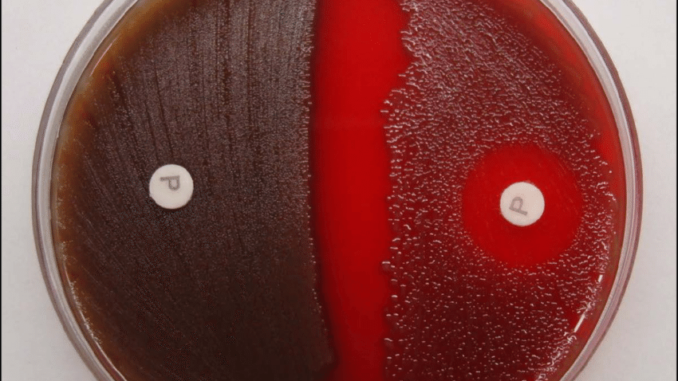
Principle:
- Optochin test is used to determine the effect of Optochin (ethylhydrocupreine hydrochloride) on an organism.
- Optochin is a chemical used as an antibiotic that interferes with the activity of enzyme ATPase and production of ATP in microorganisms.
- It helps in the presumptive identification of alpha-hemolytic Streptococcus pneumoniae (sensitive to Optochin) from other alpha-hemolytic streptococcal species (resistant to Optochin), although some pneumococcal strains are Optochin resistant.
- Optochin changes the surface tension of cell membrane of pneumoniae and makes it more fragile causing the lysis of the cell.
- Differentiating pneumococci from viridans streptococci is difficult as young pneumococcal colonies appear raised, similar to viridans streptococci and therefore Optochin sensitivity test is performed for their differentiation.
- For the Optochin susceptibility test, Optochin impregnated disc is placed on a lawn of the inoculated organism on a sheep blood agar plate. This allows the antibiotic to diffuse into the medium.
- The antibiotic inhibits the growth of a susceptible organism forming a zone of inhibition around the disc. A zone of 14mm or greater is considered susceptible and presumptive identification for Streptococcus pneumoniae. No zone of inhibition around the disc indicates resistant organism.
Requirements:
- Test organism (alpha hemolytic)
- 5% sheep blood agar plate
- Inoculating loops
- Sterile forceps
- Optochin impregnated discs
- Control organisms
- Positive or susceptible: Streptococcus pneumoniae
- Negative or resistant: Streptococcus mitis
Procedure:
- An isolated colony of the alpha-hemolytic organism to be tested was selected with a sterile inoculating loop.
- It was then streaked onto a 5% sheep blood agar plate in order to make a lawn culture.
- Using sterile forceps, an Optochin impregnated disc was placed on the inoculated surface of the agar.
- The disc was then gently pressed so that it would adhere firmly to the agar surface.
- The plate was incubated at 35-37°C for 18-24 hours in 5 to 10% CO2.
- After complete incubation, the plate was examined and observed for the zone of inhibition around the disc. The zone of inhibition (if any) was then measured .
Result Interpretation:
- Positive test or Optochin Sensitive: The zone of inhibition is 14 mm or more around a 6mm disc. The organism is Streptococcus pneumoniae.
- Negative test or Optochin Resistant: No zone of inhibition around the Optochin impregnated disc.
Limitations:
- Streptococcus pneumoniae isolates should be incubated in an environment enriched with CO2 because some isolates will grow poorly or not at all.
- It is a presumptive test only and further biochemical tests are recommended for complete identification.
- Any zone of inhibition less than 14 mm is questionable for pneumococci and the organism is identified as pneumococcus only if it is bile soluble.
